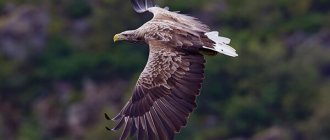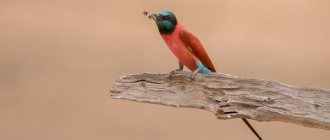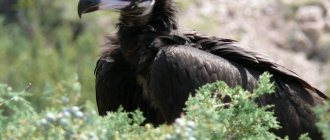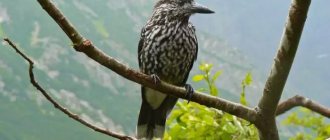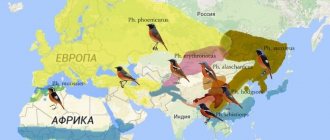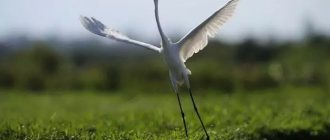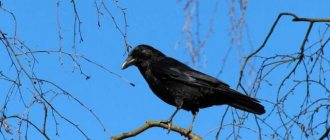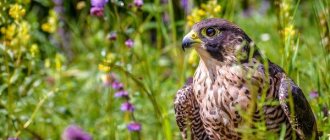| Latin name: | Haliaeetus |
| English name: | To be confirmed |
| Kingdom: | Animals |
| Type: | Chordata |
| Class: | Birds |
| Squad: | Accipitridae |
| Family: | Accipitridae |
| Genus: | Eagles |
| Body length: | 70—110 cm |
| Wing length: | 38.6—43.4 cm |
| Wingspan: | To be confirmed |
| Weight: | 3000—7000 g |
Description of the bird
The eagle is a massive, majestic bird. Its body length is from 70 to 110 cm, its wingspan is 2-2.5 m, its weight ranges from 3 to 7 kg. The beak is large, hooked, the tail and wings are wide, the legs are strong, without feathers, with curved long claws. The pads on the feet are rough, which is necessary for the bird to hold slippery prey (primarily fish). The plumage is mostly brown, with some parts of the body being white. Some species have white plumage on the head, shoulders, tail, and body. The beak is yellow.
Lifestyle and habitat
The general habitat of sea eagles extends from North America to Australia, including Greenland, Africa, much of Eurasia, the Far East, Japan and the islands of the Malay Archipelago.
Birds lead a mostly sedentary life, but under the pressure of circumstances they can wander. These circumstances can be: harsh winter, decrease in game, human economic activity. Then the birds embark on food migrations and change nesting sites.
All species of this bird prefer to settle near water. For successful hunting, a pair of eagles requires an area with a coastline length of 10 kilometers and a total area of 8 hectares.
In addition, a sufficient amount of potential prey must be present. Another condition when choosing a living space is remoteness from human habitation and economic facilities.
The bare steppe and desert areas do not suit birds even if there are large bodies of water nearby. Coniferous and mixed forests, uneven terrain turning into rocks - this landscape attracts birds to build a nest.
Dietary features of the eagle
— Advertising —
The eagle's diet mainly consists of fish and waterfowl. The eagle's prey is usually large fish weighing from 2 to 3 kg (salmon, pike, carp); among water birds, the eagle hunts gulls, herons, geese, storks, ducks, and flamingos. The eagle looks out for its victims from tall trees or in flight around a pond.
Having noticed prey, the predator approaches it very quickly: it plunges its long claws into the birds right in the air, and deftly snatches the fish from the surface of the water, but never dives under the water after it. If there is a lot of fish in a reservoir, then up to ten eagles can hunt in the same place. During such joint hunting, birds often steal or take each other's prey.
Eagles also feed on carrion, eating fish found on the shore, the corpses of deer, hares, beavers, muskrats, rabbits, and whales.
Lifestyle
Eagles are diurnal. They are territorial, the size of their nesting area is significant. They do not form nesting settlements. If suitable biotopes are limited, they can nest close to each other, but at a distance of at least 1-2 km. Their distribution often depends on the presence of large trees capable of supporting massive nests, the abundance of prey, and the absence of human disturbance.
During the wintering grounds, eagles can gather together in dozens of individuals, especially at fish processing and fish breeding enterprises, in ports, at seaside landfills and cattle burial grounds.
Eagles live along the shores of seas, large lakes and rivers. Nests are made on large trees, rocks or coastal cliffs. Good soarers, they usually look for prey from the air. They can use subtle updrafts and fly very high into the sky without a single flap. During mating games, eagles perform spectacular paired flips and somersaults in the air. Protecting themselves from other birds of prey, they easily turn upside down and continue flying.
Photo credit: Jim Bendon, CC BY-SA 2.0
Bird distribution
— Advertising —
Sea eagles are very widespread and are not found only in Antarctica and South America. Birds of this species always stay near bodies of water: near the banks of rivers, lakes, seas, they do not fly inland. This is explained by the fact that eagles obtain their main food in or near water. Eagles are sedentary birds, but in cold winters, when water bodies freeze, they migrate south.
Reasons for the appearance of the Black Book
If the Red Book is a cry for help, then the black edition is a condemnation and warning to all humanity. The book, created in the 20th century, covers the stages from 1500 to the present.
The contents of the pages of the Black Book show that over the past five centuries more than 1 thousand populations have completely disappeared. Their existence on the planet is proven by cultural monuments and traveler records.
Data about them remained only in sketches and pictures. No one saw them alive again. Therefore, a section of the Red Book was created - the Black Volume, which continues to be updated annually with information about extinct species.
Common species of sea eagle
White-bellied sea eagle (Haliaeetus leucogaster)
The body length of females of this species is from 80 to 85 cm, males from 75 to 77 cm. The wingspan is 180-218 cm. The weight of adults is from 4 to 5 kg. The distinctive features of the white-bellied sea eagle are its head, chest, wing coverts and white tail. The back and wings are gray on top. The tail is short, wedge-shaped. In young birds, the plumage color is brown, it gradually becomes white, by 5-6 years.
The species lives on the sea coasts of the tropical regions of Asia, New Guinea, Australia and Tasmania, and is vulnerable.
Bald eagle (Haliaeetus leucocephalus)
The bird's body length is from 70 to 120 cm, its wingspan is 180-230 cm, and its weight ranges from 3 to 6.3 kg. Females are larger in size than males and have the same plumage. The wings are wide, rounded, the tail is medium length, wedge-shaped. The beak is large, hooked, golden yellow in color. There are growths on the brow ridges of the skull. The paws are not feathered, yellow in color. The iris is yellow.
The head and tail are white, the rest of the bird’s plumage is dark brown, almost black. The chicks are born in gray-white downy plumage. The first color of the young is chocolate brown with white spots on the inside of the wings and shoulders. Gradually, the plumage becomes variegated, and by the age of 4 it acquires a characteristic adult appearance.
The bald eagle is found in Canada and the United States, and occasionally in Mexico. The bird also nests on the islands of Saint-Pierre and Miquelon. For life it prefers the shores of oceans, estuaries, large lakes or rivers. Seasonal migrations depend on whether bodies of water freeze in the region where each particular population lives.
Steller's sea eagle (Haliaeetus pelagicus)
The body length of the species is 105-112 cm, the wing length is from 57 to 68 cm, and the weight is from 7.5 to 9 kg. The plumage of adult birds combines dark brown with white. The forehead, lower legs, lesser and middle coverts, as well as the tail wings are white, the rest of the body is dark brown. Young birds have pronounced buffy streaks, which disappear before the age of 3 years. The iris is light brown, the beak is yellowish-brown, large, the legs are yellow with black claws.
The species is distributed in Kamchatka, along the coast of the Sea of Okhotsk, on the Koryak Plateau, along the Amur, on Sakhalin, the Shantar and Kuril Islands, in Korea.
White-tailed eagle (Haliaeetus albicilla)
The white-tailed eagle is the fourth largest bird of prey in Europe. Its body length is from 70 to 90 cm, its wingspan is about 2 m, its weight is 4-7 kg. The female is usually larger than the males. The tail is short, wedge-shaped. Adults are brown with a yellowish head and neck, and a white tail. The beak is powerful, light yellow. Rainbow is yellow. The paws are not feathered. Juvenile birds are dark brown with a dark gray beak.
Long-tailed eagle (Haliaeetus leucoryphus)
The bird's body length is from 72 to 84 cm, wingspan is 180-205 cm. Weight in females is from 2.1 to 3.7 kg, in males 2-3.3 kg. The bird has a bright brown hood, a white face, dark brown wings, and a rufous back. The tail is black with a white stripe in the middle. The young are monochromatic, dark, without a stripe on the tail.
The species' habitat includes Central Asia, from the Caspian and Yellow Seas, Kazakhstan and Mongolia to the Himalayan Mountains, Pakistan, India, and Bangladesh. The species is partially migratory.
Screamer eagle (Haliaeetus vocifer)
A medium-sized bird with a body length of 63 to 57 cm, a wingspan of up to 210 cm. Females are larger than males and weigh from 3.2 to 3.6 kg, while the latter from 2 to 2.5 kg. The plumage in the head, neck, tail, upper chest and back is white, all other parts of the body are chestnut or gray. The feathers on the tips of the wings are black. The beak is yellow, the tip is black, the legs are light yellow.
The species is found in Africa south of the Sahara at altitudes up to 1000 m above sea level, close to water bodies.
Bibliography
- ABC of nature. More than 1000 questions and answers about our planet, its flora and fauna. M.: Reader's Digest Publishing House, 1997. 336 p.
- Averin Yu. V. Terrestrial vertebrates of Eastern Kamchatka // Proceedings of the Kronotsky State Natural Biosphere Reserve. Vol. 1. Petropavlovsk-Kamchatsky, 2013. 260 p.
- Boehme R. L., Flint V. E. Five-language dictionary of animal names. Birds. Latin – Russian – English – German – French. M.: Rus. language RUSSO, 1994. 845 p.
- Boehme R. L., Dinets V. L., Flint V. E., Cherenkov A. E. Birds. Encyclopedia of Russian nature. M., 1996. 432 p.
- Buturlin S. A., Dementyev G. P. Complete guide to birds of the USSR. T. M.-L.: KOIZ, 1936. 254 p.
- Byshnev I.I. Birds over the Berezina. Minsk: Urajai, 1993. 352 p.
- All about birds. Atlas-directory. St. Petersburg: SZKEO LLC, 2007. 176 p.
- Galushin V.M., Drozdov N.N., Ilyichev V.D. and others. Edited by Ilyichev V.D. Fauna of the world: Birds: Handbook. M.: Agropromizdat, 1991. 331 p.
- Ganzak Jan Illustrated Encyclopedia of Birds. Prague: Artia Publishing House, 1974. 583 p.
- Dementyev G.P., Gladkov N.A., Ptushenko E.S. et al. Birds of the Soviet Union. T. M.: Soviet Science, 1951. 652 p.
- Koblik E. A. Diversity of birds (based on materials from the exhibition of the Zoological Museum of Moscow State University), Part 1, M.: Moscow State University Publishing House, 2001. 384 p.
- Koblik E. A., Arkhipov V. Yu. Bird fauna of the countries of Northern Eurasia within the borders of the former USSR: lists of species. Zoological Research, No. M.: Partnership of Scientific Publications KMK, 2014. 171 p.
- Kolyada A. S., Glushchenko Yu. N. On the origin and synonyms of Russian names of birds of Primorye // Animal and plant world of the Far East. Vol. 12. Sat. scientific tr. Ussuriysk: UGPI Publishing House, 2008. pp. 50-74.
- Leonard Lee Ru III Animal World. Predator birds. Minsk: Belfax, 1995. 80 p.
- Preobrazhensky A. Etymological dictionary of the Russian language. T. M.: Printing house of G. Lissker and D. Sovko, 1910-1914. 674 pp.
- Ryabitsev V.K. Birds of the Urals, the Urals and Western Siberia: A reference guide. Ekaterinburg: Ural Publishing House. Univ., 2008. 634 p.
- Skaldina O.V. Red Book. Birds of Russia. M.: Eksmo, 2013. 240 p.
- Stepanyan L. S. Abstract of the ornithological fauna of the USSR. M., 1990. 728 p.
- Tsyganenko G.P. Etymological dictionary of the Russian language: More than 5000 words. K.: Glad. school, 1989. 511 p.
- Shansky N. M. School etymological dictionary of the Russian language. Origin of words. M.: Bustard, 2002. 400 p.
- https://www.datazone.birdlife.org
- https://www.hbw.com/species
- https://www.sevin.ru/redbooksevin/index.html?content/167.html
- https://www.inaturalist.org/taxa/5303-Haliaeetus
- https://animalkingdom.su/books/item/f00/s00/z0000070/st016.shtml
- https://www.rbcu.ru/campaign/24808/
- https://www.rbcu.ru/campaign/24814/
- https://en.wikipedia.org/wiki/Madagascan_fish_eagle
- https://en.wikipedia.org/wiki/Sanford%27s_sea_eagle
- https://ru.wikipedia.org/wiki/Bald_eagle
- https://ru.wikipedia.org/wiki/White-bellied_eagle
- https://ru.wikipedia.org/wiki/Orlan_screamer
- https://www.infoniac.ru/news/Lyubopytnye-fakty-o-belogolovom-orlane.html
- https://numizmat.com.ua/catalog/coins/?1109
- https://geraldika.ru/symbols/30096
- https://geraldika.ru/symbols/6470
- https://geraldika.ru/symbols/1534
Author of the article: Svetlana Kondrukhova, ornithologist
Did you like the article? Share with your friends:
Sea eagle breeding
Eagles are monogamous birds, they live in pairs, occupying the same section of the coast for many years, where the birds build their nest on the highest tree.
Eagle nests are found on dead trees or their dry tops, since living thin branches cannot withstand the weight of a huge nest. Its diameter is from 1.5 to 3 m, its height is about 1 m, and its weight can reach 1 ton. The largest known eagle nest weighed 2.7 tons. The nest is built by the female, and the male brings her building material. Every year the eagles renovate and complete their nest.
The mating season for eagles begins in March or April. At this time, predators circle in mating flights, when partners in the air clasp their claws and rush to the ground, turning around their axis.
In one clutch, a female eagle has from 1 to 3 eggs, which she incubates for 34 to 38 days. The chicks are born covered with white down, absolutely helpless. The female guards them, while the male gets food - fish and meat. From a brood, as a rule, one chick survives, the largest and strongest. At the age of 3 months, young eagles begin to fly, but for several months they remain close to their parents.
Eagles reach sexual maturity at the age of 4 years. Their lifespan is about 20 years in the wild, and up to 50 years in captivity.
Enemies in the wild
Only humans are dangerous to eagles. These predators are extremely sensitive to disturbance during the hatching period. They are often shot by poachers for entertainment and trophies. Eagle nests are destroyed during fires and deforestation. Birds are poisoned with lead in places where hunting of waterfowl and near-water game is permitted. High-voltage power lines pose a particular danger to eagles; if they come into contact with them, they die from electric shock.
Photo credit: Bernard Gagnon, CC BY-SA 4.0
Interesting facts about the bird
- The White-bellied Sea Eagle is the official symbol of the Malaysian state of Selangor and Booderee National Park (Jervis Bay). The bird is featured on the Singapore banknote (S$10,000).
- Since 1782, the eagle has become the official national bird of the United States; its images are placed on the coat of arms, presidential standard, banknotes, and logos of national corporations.
- The screaming eagle is the national symbol of Zambia; its image is featured on the country’s flag, coat of arms and banknotes. In addition, the bird is depicted on the coat of arms of Namibia and South Sudan.
- Due to their enormous size, the eagles' nests were included in the Guinness Book of Records.
- Over the past two centuries, there has been a decline in the population of eagles due to their mass extermination and human economic activity. Birds have been particularly harmed by the use of DDT to kill insect pests. Laws have been introduced in the United States that prohibit the killing and ownership of eagles. The ban on the use of insecticides and conservation measures are leading to a gradual restoration of the number of birds.
origin of name
Externally, sea eagles are very similar to eagles, hence their name. The suffix –an in the word “eagle” is most likely increasing, so the name itself may mean “big eagle.” The appearance of these birds is more “majestic”, which is why eagles are often depicted on coats of arms.
Orel is an old Russian, Proto-Slavic word found in many languages of the Indo-European language family. Originally orьлъ “eagle” meant “big bird”, the suffix –ьлъ was magnifying. The word is derived from the root or–, which is found in the Greek ŏrnis “bird”. The meaning of the root or– in Greek means “I rush, I rush”, in Latin it means “I rise, I rise.” It is believed that the word eagle goes back to the Indo-European root or-, meaning “supreme, divine.”
The generic Latin name Haliaeetus comes from the ancient Greek ἁλιάετος, meaning "sea eagle". This is what the eagle was called in ancient times.
Extra menu
When answering the question of what the bald eagle eats, it is necessary to mention other types of food, since it loves not only fish. These winged predators add other birds to their diet - geese, gulls, mallards, coots, pelicans, cranes and many others. They are caught on the fly or when they themselves are busy hunting and lose their vigilance. Bald eagles do not disdain chicks and eggs. Birds living in colonies are especially affected by them. A rapid fall of an eagle from a height onto a nest usually ends in success for the hunter.
These predators rarely hunt animals, so such food makes up a small percentage of their diet. Their prey includes hares, raccoons, squirrels, gophers, rats, beavers, and turtles. Bald eagles have been recorded hunting pups of sea lions, seals and sea otters.
They also do not disdain carrion. Very rarely they can be found in landfills looking for some kind of food.
Adult birds can drive coyotes, foxes, and vultures away from the carcass. Young white-headed predators, as a rule, do not enter into conflicts with these animals.
On the verge of extinction
They began to exterminate eagles for meat and just so that they would not interfere with the settlers’ lives. The continent began to develop land and actively engaged in agriculture. Deforestation and urban construction have significantly reduced the habitat of eagles, and the chemicals used in agriculture have negatively affected the health of the birds, whose eggs have become very fragile. Now they could not even withstand the weight of the female incubating them and burst.
There came a time when ornithologists counted only 487 pairs on the entire continent. Scientists raised the alarm. As a result, it was prohibited to use DDT in agriculture, a chemical from which birds suffered the most. In 1940, the United States passed a law according to which it is prohibited not only to shoot bald eagles (for any purpose), but also to keep them in captivity (except in nature reserves), and also to use any parts of their body, including feathers. An exception is made only for Indian rituals, but you need to buy a license to shoot each eagle. Now there are more than 115 thousand of these birds in the world.
Who studies extinct animals
The science of paleontology studies animals that have disappeared forever from the planet. For a long time, scientists had to only guess what the fossils looked like, the appearance of which is impossible to discern among the fossils. Japanese scientists have developed a method that allows them to reconstruct reliable anatomy from the remains.
On the eve of 2011, Russian paleontologists from Yakutia discovered the remains of a baby mammoth that died almost 30 thousand years ago. Scientists were able to recover part of the animal's DNA. Researchers found that the baby mammoth died from an attack by cave lions.
Baby Mammoth
A detailed study of fossilized remains will reveal the living conditions of extinct animals.
Fish menu
Where the bald eagle lives, there must be a large body of water, because their main food is fish. These birds do not dive for their prey. Having noticed the victim from above, they fall down like a stone, grab the fish with their claws and immediately soar into the heights. At the same time, only a few feathers of eagles can get wet. When falling, they reach speeds of up to 160 km/h, so the fish have no chance to escape. The diet of bald eagles includes sockeye salmon, pink salmon, chinook salmon, herring, trout, mullet - any fish that they are able to lift and carry to the place of their meal. They do not hunt for small change, as it slips between their fingers. White-headed predators are also not interested in live fish larger than 3-4 kg.
They can peck fry in shallow water. Large fish are eaten as carrion when they are washed ashore by the waves.
Often these birds do not bother themselves with catching prey, but take it away from smaller birds - crows, ospreys, red-tailed buzzards. If during the “racket” the unlucky hunter does not have time to escape or tries to resist, he, too, can become the feathered bandit’s dinner.
